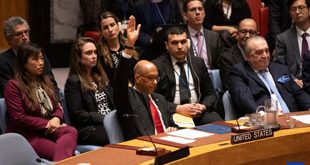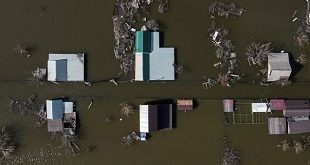
Thoreau, United States | AFP | Amanda Larson pulls up at a water station a few miles from her home in the Navajo Nation and her three children get to work filling up large bottles lying on the bed of her pickup truck.
The 66 gallons will be used by her family for drinking, washing clothes and bathing — before the next trip out in two or three days to repeat the back-breaking task.
“It’s embarrassing, it’s degrading, it’s heartbreaking for my kids because they can’t jump into a shower like everybody else and just wash,” the 35-year-old preschool teacher tells AFP after returning to her prefabricated home in Thoreau, which lies in the southeast corner of this sovereign territory, the United States’ largest Native American reservation.
“This is how we get ready for school, this is how my husband and I are getting ready for work, in these two totes,” she says, pointing to large plastic containers placed inside the bathtub.
According to the Centers for Disease Control and Prevention, “Washing your hands is easy, and it’s one of the most effective ways to prevent the spread of germs,” advice it has relentlessly emphasized over the course of the coronavirus pandemic.
That’s just not possible for an estimated 30 to 40 percent of the Nation’s 178,000 residents, who don’t have access to running water or sanitation.
This is seen as a major reason behind the surge in COVID-19 cases within the territory, with nearly 5,000 confirmed infections and 160 deaths — one of the highest per capita fatality rates in the country.
– Two million Americans without water –
“Water is life,” say the Navajo, who prefer to call themselves “Dine” and their land “Dinetah.”
These three words are spray painted on walls throughout a geographically diverse territory that stretches 27,400 square miles (about the size of Scotland) across Arizona, Utah and New Mexico, a land of arid deserts with striking sandstone formations that give way to high plateaus and alpine forests.
It’s a sentiment also reflected in place names: Sweetwater, Many Farms Lake, Willow Spring.
But these names often no longer reflect reality.
Rising temperatures and declining rainfall led to a decrease in the area’s surface water by an estimated 98 percent over the 20th century, according to a report by water nonprofit DigDeep.
Chronic neglect by the government is another aspect to this story, says George McGraw, who founded DigDeep in 2012 to help communities in Sub-Saharan Africa but who has since shifted his focus to America.
Starting in the mid-19th century, the US began heavily investing in water and sanitation systems — but an estimated two million of America’s 330 million people remain unconnected to this day.
“There are these gigantic swaths of the country, mostly black, brown, indigenous and rural, that were bypassed when it came to the major federal infrastructural investment that was made to service the rest of the country,” he told AFP.
Native Americans are the hardest hit group: 58 out of every 1,000 households lack complete plumbing, compared to three out of every 1,000 among whites.
The Navajo signed a treaty with the US government in 1868, four years after they were forced from their homeland in a mass deportation called the Long Walk of the Navajo.
In exchange for giving up their resistance to the colonizers, as well as vast tracts of land, they were promised basic necessities such as education and healthcare in perpetuity.
A 1908 Supreme Court judgement emphasized that the creation of reservations also included an implicit right to water sufficient to fulfill the territories’ purpose — but left open the thorny question of how much that was, an ambiguity that has prevented enforcement.
By contrast, southwestern states built hundreds of dams in the following decades, creating plentiful supply for their residents, often at the expense of Indian reservations.
– Sugary drinks drive diabetes –
Apart from the ability to wash your hands, a lack of water has several secondary effects, explained Dr Loretta Christensen, the chief medical officer for the area for the Indian Health Service (IHS).
“The ability to shelter in place to self-isolate, quarantine, is dependent on having very rudimentary things available to you such as water, food and the products necessary to both disinfect your house and to wash your hands and have really good hygiene,” she said.
“So I think it has a huge impact on the general health of the population, but certainly in a time when you’re fighting a very potent microbe I think it’s even much more intensified.”
Water access also dovetails into another important public health challenge for the Navajo — a high rate of diabetes, which has been shown to worsen the disease progression of the COVID-19 illness by supercharging an abnormal immune response that ravages the lungs.
Sugary beverages are often more readily available than clean water, driving up Type-2 diabetes rates among Navajo to two to four times that among whites.
Scarce water supplies also drive overcrowding, with multiple families forced to live in the same space to share a shower.
– Uranium contaminated wells –
Nikishia Anthony, 25, lives with her boyfriend and his family in White Clay, a green, wooded settlement in the center of the Nation, some 7,500 feet (2,300 meters) above sea level.
The area is remote and accessible only by dirt paths that require four wheel drive vehicles.
On a hot spring day, she receives a delivery organized by the Johns Hopkins Center for American Indian Health, one of several groups active in the area, which is also providing families hand washing stations that were first developed for use in Africa.
She says she’ll use the water to wash bottles and feed formula milk to her baby Xavier, born last week.
During the region’s harsh winter, Anthony’s family uses snow to wash their clothes and dishes.
Otherwise, they depend on windmill-pumped water from a well about a mile away. But it takes time to draw water from the ground, and ever since the pandemic wait times have grown longer as multiple families use them.
While windmills dot the landscape, there are other good reasons to avoid them: many are polluted with microbes, or even radiation — the result of contamination from some 521 abandoned uranium mines.
They are still used to water livestock, however, and these will eventually be eaten.
According to DigDeep’s report, “Gastric cancer rates doubled in the 1990s in some areas where uranium mining occurred.”
– Waiting lists –
While Anthony lives in a remote area, being close to a water line isn’t always enough to guarantee a connection.
Larson, the teacher, lives 250 yards (meters) from a main line and says she’s been on a three-year waiting list with the IHS to get her home connected.
Last year, DigDeep installed a 1,200 gallon tank under her home that gets refilled once a month and is used to provide water to the kitchen area.
That, she said, has made a “big difference” because “I can just kind of get a normal breakfast boiling and normal dinner going.”
Still, between the water station fill-ups every three days and the monthly top up of her kitchen tank, the family consumes just 3,200 gallons (12,000 liters) of water, about a third what the average American family goes through.
Water groups like DigDeep are carrying out experiments with atmospheric water extraction, as well as exploring methods to decontaminate ground water at lower costs — but these technologies remain in their infancy.
Given the tough terrain, the IHS places the current cost of outstanding sanitation projects on the Navajo reservation at $520 million.
The Nation’s President Jonathan Nez has vowed to use some of the $600 million the territory has so far received in coronavirus stimulus funding to address the problem.
But the Nation would still need to reach final settlements with two of the three states it spans (Utah and Arizona) on how much water it can divert from the Colorado River, the San Juan River and their tributaries.
Even so, Larson said she was hopeful, and was actively calling up the IHS and her local political representatives to try to push her case.
“The main issue in the Navajo Nation is running water, and they need to address that right away,” she said.
 The Independent Uganda: You get the Truth we Pay the Price
The Independent Uganda: You get the Truth we Pay the Price


